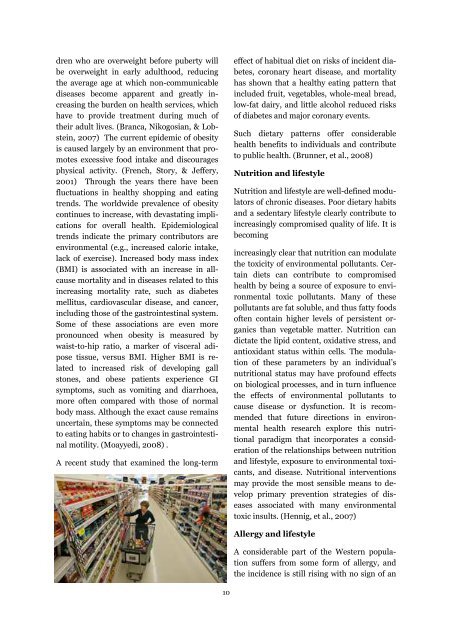ISSN 1683-3805
E&HI Volume 11, No. 1 2009 - International Federation of ...
E&HI Volume 11, No. 1 2009 - International Federation of ...
- No tags were found...
You also want an ePaper? Increase the reach of your titles
YUMPU automatically turns print PDFs into web optimized ePapers that Google loves.
dren who are overweight before puberty will<br />
be overweight in early adulthood, reducing<br />
the average age at which non-communicable<br />
diseases become apparent and greatly increasing<br />
the burden on health services, which<br />
have to provide treatment during much of<br />
their adult lives. (Branca, Nikogosian, & Lobstein,<br />
2007) The current epidemic of obesity<br />
is caused largely by an environment that promotes<br />
excessive food intake and discourages<br />
physical activity. (French, Story, & Jeffery,<br />
2001) Through the years there have been<br />
fluctuations in healthy shopping and eating<br />
trends. The worldwide prevalence of obesity<br />
continues to increase, with devastating implications<br />
for overall health. Epidemiological<br />
trends indicate the primary contributors are<br />
environmental (e.g., increased caloric intake,<br />
lack of exercise). Increased body mass index<br />
(BMI) is associated with an increase in allcause<br />
mortality and in diseases related to this<br />
increasing mortality rate, such as diabetes<br />
mellitus, cardiovascular disease, and cancer,<br />
including those of the gastrointestinal system.<br />
Some of these associations are even more<br />
pronounced when obesity is measured by<br />
waist-to-hip ratio, a marker of visceral adipose<br />
tissue, versus BMI. Higher BMI is related<br />
to increased risk of developing gall<br />
stones, and obese patients experience GI<br />
symptoms, such as vomiting and diarrhoea,<br />
more often compared with those of normal<br />
body mass. Although the exact cause remains<br />
uncertain, these symptoms may be connected<br />
to eating habits or to changes in gastrointestinal<br />
motility. (Moayyedi, 2008) .<br />
A recent study that examined the long-term<br />
effect of habitual diet on risks of incident diabetes,<br />
coronary heart disease, and mortality<br />
has shown that a healthy eating pattern that<br />
included fruit, vegetables, whole-meal bread,<br />
low-fat dairy, and little alcohol reduced risks<br />
of diabetes and major coronary events.<br />
Such dietary patterns offer considerable<br />
health benefits to individuals and contribute<br />
to public health. (Brunner, et al., 2008)<br />
Nutrition and lifestyle<br />
Nutrition and lifestyle are well-defined modulators<br />
of chronic diseases. Poor dietary habits<br />
and a sedentary lifestyle clearly contribute to<br />
increasingly compromised quality of life. It is<br />
becoming<br />
increasingly clear that nutrition can modulate<br />
the toxicity of environmental pollutants. Certain<br />
diets can contribute to compromised<br />
health by being a source of exposure to environmental<br />
toxic pollutants. Many of these<br />
pollutants are fat soluble, and thus fatty foods<br />
often contain higher levels of persistent organics<br />
than vegetable matter. Nutrition can<br />
dictate the lipid content, oxidative stress, and<br />
antioxidant status within cells. The modulation<br />
of these parameters by an individual’s<br />
nutritional status may have profound effects<br />
on biological processes, and in turn influence<br />
the effects of environmental pollutants to<br />
cause disease or dysfunction. It is recommended<br />
that future directions in environmental<br />
health research explore this nutritional<br />
paradigm that incorporates a consideration<br />
of the relationships between nutrition<br />
and lifestyle, exposure to environmental toxicants,<br />
and disease. Nutritional interventions<br />
may provide the most sensible means to develop<br />
primary prevention strategies of diseases<br />
associated with many environmental<br />
toxic insults. (Hennig, et al., 2007)<br />
Allergy and lifestyle<br />
A considerable part of the Western population<br />
suffers from some form of allergy, and<br />
the incidence is still rising with no sign of an<br />
10



